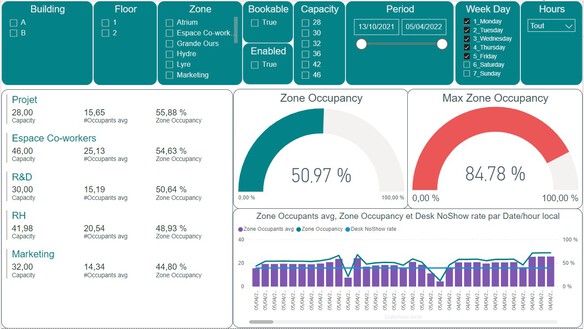Make a successful transition to Flex Office
Table of content:
Make a successful transition to Flex Office

What is Flex Office?
The idea of the Flex Office is mainly based on the observation that employees are not present on site every day, especially with the introduction of teleworking. The office space is more or less unoccupied and there is therefore a possible optimization of the total area in order to reduce the operating costs of the building and its environmental impact.
The workspace offers a number of desks less than the number of employees based on an average occupancy ratio taking into account the habits of teleworking and presence of employees.
In terms of layouts, there are mostly open spaces which offer traditional workstations, but also new spaces, sometimes playful, promoting collaboration and teamwork unlike teleworking focuses on individual work.
Good reasons to switch to Flex Office?
Let us be frank, the Flex Office does not always have a good reputation and can be perceived by users as a regress compared to the assigned and partitioned desktop model. However, there are good reasons to adopt the Flex Office beyond costs issues. The key is to consider these good reasons and to get all stakeholders embrace them. Let’s start by detailing them.
Promoting teamwork and creativity
At a time of new working methods, and in particular project management in Agile mode, we often see teams with changing size and scope. It is therefore essential that the working environment can adapt to these changes. Let’s take a concrete example: a project team must reinforce these staff punctually to catch up. This reinforcement can be done with collaborators from the same site with outstanding skills from other teams working on related subjects. If the workspaces are “flexible” enough to allow this extended team to be co-located over a given period of time, the work will be more efficient, the exchanges simpler, more direct and faster.
The corollary of a better work in the team is to promote the creativity. The creation of unassigned workstations obviously makes it possible to adapt to the changing numbers of the teams, as we have just seen, but also allows, conversely, for an employee to be with the other teams with whom she/he may not be used to work. And this allows to discover other atmospheres, perhaps even other working methods, and to change them willingly; in short, to get out of one’s routine, and consequently, to enrich one’s creative potential.

Adapting to the new needs of workers
Let us take another, more individual angle: if we consider all the tasks and activities of an employee, they may require a wide variety of postures and methods. Some will need isolating themselves to concentrate, others on the contrary need to work in team, still others to connect remotely, etc. Again, if the working environment can facilitate and support the simple and fluid transition between these different activities, then the quality of work and the quality of life at work will be enhanced.
Optimize your real estate footprint
Of course, in this context, the teleworking will be seen as a complement to the Flex Office. The employee gains a better balance between professional and personal life. The property manager optimizes the sqm.
It is well understood that as the teleworking increases the on-site presence rate reduces as well as the desk/employee ratio. Therefore, reducing the number of available desks allows to reduce the total surface area and associated costs.
The challenge is to apply the best ratio which allows these cost reductions while respecting the new needs of employees and teams. But, in a company, each function and each team is different, and a single ratio applied to all is not adapted. This variability in needs is reinforced by the evolution of the world of work and the massive introduction of teleworking: between a salesperson and an IT developer working in an Agile Scrum, the ways of working, the use of teleworking and office needs are not the same. Applying the same ratio to all is therefore at best a sub-optimization, at worst a factor of strong frustration for some of the employees and can lead to most serious problems related to the well-being and motivation of the employees, or even to derail the Flex Office transformation project.
Therefore, it is important to identify the risks and consider best practices for a successful Flex Office transition.
The risks of Flex Office
The loss of the assigned desk and the lack of customization of the workstation may lead to the loss of reference for some employees. The commitment of employees can be affected because they can feel the Flex Office as a dehumanization of work. This organization can also lead to difficulties in the integration of new employees who can quickly feel isolated. It is therefore essential to protect and strengthen the team cohesion when implementing the Flex Office.
The Flex Office can also be an additional obstacle in the working day of employees due to the difficulty of finding an adequate place and an additional waste of time. The Flex Office is often attached to the fear of lack of space and to the “first come, first served” type. It is therefore necessary to put in place the tools to guarantee a place for employees on site and facilitate the localization and reservation of desks.
The Flex Office is also attached to the fear of a too noisy work environment: an example of the calls from sales representatives and managers who put away the technical teams who need calm to carry out their work. It is then necessary to adapt and organize the spaces and teams in relation to the needs of the different functions.
Best practices for a Flex Office transition

Involve employees
First of all, it is essential to involve the employees, and this as much as possible, at the early stage of the project. The means of achieving this are quite classic, such as setting up working groups in charge of specific subjects, such as the design of informal areas, the meeting rooms equipments, the testing of furniture elements (desk, chair, etc.).
The members of these working groups will also have the role of ambassadors of the project to their colleagues.
The regular information and discussion points for all employees are also a simple tool to implement. Beyond informing about the progress of the project, the aim is also to make employees express their feelings, fears, wishes, needs and to ask all questions.
The key to a successful involvement lies more in the authentic will of the initiators of the project than in the methods used. A trivial counter-example would be, for instance, to continue to reserve “private” spaces for some managers/executives when all other employees switch to the Flex Office. The transition to Flex Office therefore requires a certain degree of horizontality.
Inform/consult the representative bodies
Despite everything, companies operate in an environment structured by the law, the labour code and in this context, it is therefore worth recalling that information/consultation with the bodies represented in the company is essential.
And in addition to mandatory consultation steps, these bodies are responsible for a variety of topics related to a project for transition to Flex Office. These include the Commission for Health, Safety and Working Conditions (CSSCT), which will be able to intervene, through its recommendations, on the themes of safety and more generally on the quality of life at work. See also our blog post on How Smart Office can support health and safety at work.
Flex Office tools
The Flex Office naturally implies a change in the organization of work and associated processes. And these changes can be supported by shared space management software and smart offices.
A major challenge of a Flex Office project is to be able to manage the transformation and allocation of spaces by taking into account the needs of each team, each type of employee and to identify opportunities for space optimization.
Measure, identify opportunities, apply changes… then start again: this is where the digitalization of workspaces and the introduction of a Flex Office application makes it possible to systematize a continuous adaptation of office spaces.
If previously, Flex Office transformation projects were based on a single ratio calculated a priori, a Flex Office solution will allow facility managers to manage over time the adaptation of spaces based on booking and factual occupancy data and according to the growth of the company and the needs of each team.
For employees, the fact of no longer having an assigned desk is unsettling at first glance and the team spirit is potentially affected. An application to book and organize the space allows employees to better project themselves in these new spaces: the team life and the motivation of the employees are then strengthened.
The pitfalls of Flex Office

That said, the tool obviously does not guarantee a successful switch to the Flex Office. It is one of the traps to be avoided.
Rely only on tools
We still too often see the introduction of a Flex Office management tool as the only or at least the first response to the needs and questions of employees in this situation of change.
This is a mistake firstly because the implementation and use of this tool is generally taking place in the last stages of the project and therefore too late to hope for a strong endorsement and involvement of the employees.
So, we come back to our first point: to involve all employees as soon as possible. But here also, beware of the trap…
Employee involvement
It is understandable that, for organizations, the optimization of operating costs is a strong reason for the transition to Flex Office. But if this is the only one reason (said or not), then the adhesion and success of the project are compromised.
Failure to consider the other “good reasons” mentioned above and not to implement the changes associated with them to encourage teamwork, creativity, and to respond to the new needs of employees, will only accentuate the resistance to change.
And to overcome this, we have here the topics to put in the hands of the employees by giving them the appropriate autonomy level and decision power in the implementation of these changes.
Flex Office Project Tracking

Of course, not everything stops once the new environment is in place. It is necessary to maintain the involvement of employees, for example through the working groups set up for the project, in order, at a minimum, to collect the first feedbacks and to make the first adjustments if necessary.
It is also important to mention that on this type of project of transition to the Flex Office, the curve of change tends in general over a fairly long period (from several months to 1 or 2 years). That’s why it’s important to maintain dialogue with user-employees and let the chance to make certain adjustments in terms of layouts and organization.
Measure to continue to adapt
It is in this sense that a good Flex Office management tool will give you a precise and reliable vision of the use of spaces. Thus, by relying on relevant metrics, you will find levers and opportunities to improve the necessary optimizations.
This is a major element of our solution that includes tailor-made reports to track your performance indicators. See also our page on Space Occupancy Statistics.
Flex Office Monitoring Committee
The Social and Economic Committee (CSE), in its role in relaying the expression of employees and referent in the general organization of the enterprise, as well as the management of the enterprise, will have every interest in setting up a committee to analyze the key indicators of the Flex Office and to participate in the adaptation of the rules and in the reorganization of spaces and teams.